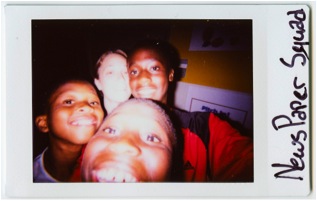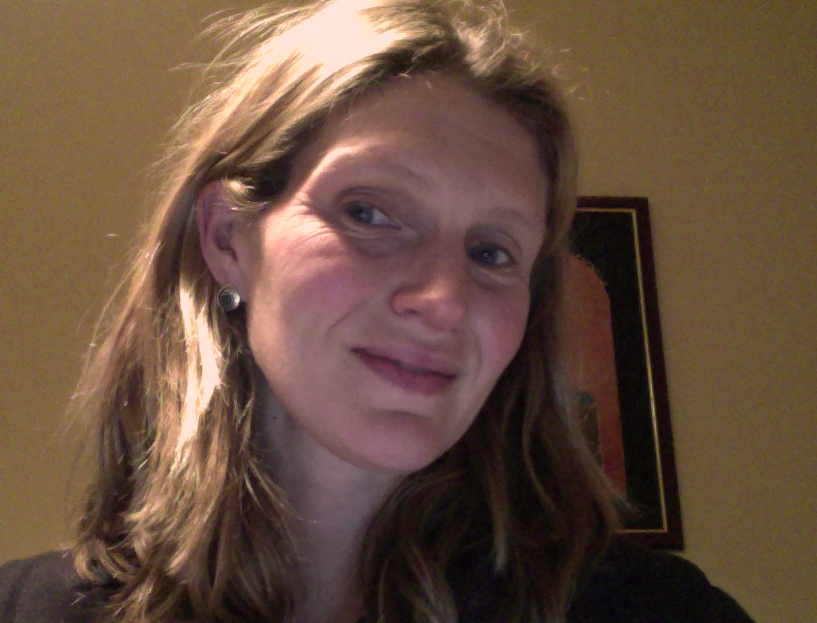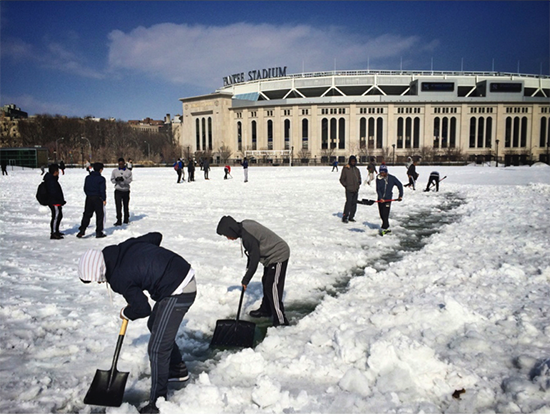By Nicholas Pilarski
I bike twenty-four blocks from my apartment in Flatbush to the housing developments of Brownsville. While riding, I watch the sun slowly rise, back-lighting the monolithic buildings that lay to the east. As light passes through the nation’s largest network of affordable housing developments, shadows divide the streets into a complex crosshatch of light and dark. This is not unlike the geography of the landscape itself, where invisible lines have divided the community from prolonged affiliated conflict, forcing many youth in the neighborhood to choose what side of the street they walk. The origin of this rivalry is a mystery to those who call Brownsville home, yet everyone is forced to abide by specific rules born from a painful history. This history predates the lives of young people walking in the streets of this community. Each housing unit is either red or blue, with the police often adding a third color into the complex negotiation of power.
The complicated, geo-political environment is not justly articulated in the stereotypes often applied to Brownsville. There is community here. There is a certain potent quality to its residents, aptly described in conversation by a young resident. Knocking on the wall with the back of her hand, she reflected: “These [buildings] are tall and made of stone. We are tall and strong like them. But people don’t see this from the outside. You come from Brownsville, people have assumptions about you. They think you are something you’re not because you come from this place. But we have a lot. It might not be like other places. But it’s our place. And a lot of us are proud of it.” Made in Brownsville shirts, namesake tattoos, and verbal affirmation exemplify this pride. Daily exchanges of proud residents greeting each other in the streets as their day begins make this sense of provenance, and community, ever more evident.
Arranged literally and figuratively as an anchor within the community is The Brownsville Community Justice Center (Center), part of the Center for Court Innovation. The pride and strength of the residents seen in the streets is reflected in the ethos created by the Center. There, a philosophy of youth-led innovations works to reconfigure relationships between community and the justice system.
Working in conjunction with the Center, I engage with five young men in a project titled “Opportunity Youth.” We explore documentary practice, from animation to the audio doc., and work to develop technical skills as a way to identify each individual’s unique, artistic voice. Currently the young men are defining their body of work, which is taking the form of photo-essays and a small group-created script that has parallels to the afro-futurist movement of the mid-1970s.


Another young man involved with the Center, Ray, is a natural community leader, taking a role in anti-violence initiatives in Brownsville. Together, Ray and I will develop a documentary video game. The medium will allow us to create proactive dialogue across divided houses and navigate Brownsville geographically, both currently not possible given lines of conflict drawn throughout the community. In a virtual environment, youth will have the freedom to explore Brownsville without these political or physical borders. Established gamers will be able to explore individual narratives of the community that they would not have access to otherwise. The primary hope of the game is for users to transcend literal and figurative obstruction of an ongoing rivalry, one in which both sides hold similar dreams and struggles. As multiple real-time users navigate a virtual Brownsville, they must work together to complete various missions, which are rooted in the shared viewing of interviews and narratives. By the end of the “docu-game,” when all missions are complete, it will be revealed that the real-time users, or “avatars,” in the game are comprised of individuals living in buildings across the whole of Brownsville. Built into the gameplay is a mechanism that theorists and practitioners Augusto Boal and Sanjoy Ganguly would call instruments to “rehearse a better reality through play.” Their interactive theatre work has led to peaceful solutions to violence in India and Brazil, where the idea of finding empathy through play is foundational to spread peace through communities in conflict. These models will be used heavily throughout development.
In order to attempt to translate Boal and Gaguly’s theatrical concepts to our virtual environment, we are excited to announce a partnership with Brooklyn-based experimental artist, Alexander Porter. Alex has generously donated an unreleased Alpha version of his 3D motion scanning software. Using this, we will record and interview participating Brownsville residents and place them in our constructed virtual world. This project still remains in its planning stages with many details and technological harnessing yet to be finalized. Images of this technology in motion are included below.



With both the five young men involved with “Opportunity Youth” and Ray, I am excited to move forward with these talented Brownsville youth. We look forward to sharing updates moving forward.



